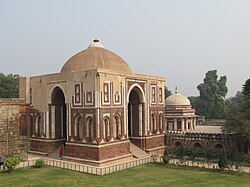

| Alai Darwaza | |
|---|---|
| Native name Urdu: علاء دروازه | |

Alai Darwaza
| |
| Location | Qutb Minar complex, Delhi, India |
| Coordinates | 28°31′27″N 77°11′09″E / 28.5242°N 77.1857°E / 28.5242; 77.1857 |
| Built | 1311 |
| Type | Cultural |
| Criteria | iv |
| Designated | 1993 (17th session) |
| Part of | Qutb Minar and its monuments |
| Region | India |
|
Location of Alai Darwaza in India | |
Ala'i Darwaza (Urdu: علاء دروازه, lit. 'Gate of Alauddin') is the southern gateway of the Quwwat-ul-Islam Mosque in Qutb complex, Mehrauli, Delhi, India. Built by Sultan Alauddin Khalji in 1311 and made of red sandstone, it is a square domed gatehouse with arched entrances and houses a single chamber.
It has a special significance in Indo-Islamic architecture as the first Indian monument to be built using Islamic methods of construction and ornamentation and is a World Heritage Site.[1]
The Alai Darwaza was built by Delhi Sultan Alauddin Khalji of the Khalji dynasty in 1311. It was a part of his plan to extend the Quwwat-ul-Islam Mosque on four sides. Although he planned to construct four gates, only the Alai Darwaza could be completed as he died in 1316.[2] It serves as the southern gateway of the mosque.[1] It is located at the southern part of the Qutb complex.[2]
In 1993, the Darwaza and the other monuments of the complex were designated a World Heritage Site.[3] The surrounding of Qutb Minar including many tombs,mosque and Iron pillar is called Qutb Complex
The Alai Darwaza is made up of a single hall whose interior part measures 34.5 feet (10.5 m) and exterior part measures 56.5 feet (17.2 m).[2] It is 60 feet (18 m) tall and the walls are 11 feet (3.4 m) thick.[4]
The gatehouse, from 1311, still shows a cautious approach to the new technology, with very thick walls and a shallow dome, only visible from a certain distance or height. Bold contrasting colors of masonry, with red sandstone and white marble, introduce what was to become a common feature of Indo-Islamic architecture, substituting for the polychrome tiles used in Persia and Central Asia. The pointed arches come together slightly at their base, giving a mild horseshoe arch effect, and their internal edges are not cusped but lined with conventionalized "spearhead" projections, possibly representing lotus buds. Net, stone openwork screens, are introduced here; they already had been long used in temples.[5]
The height of the dome is 47 feet (14 m).[2] It is the first true dome built in India, as previous attempts to construct a true dome were not successful.[2]
The entire Darwaza is made up of red sandstone with white colored marbles inlaid on the exterior walls.[6] There is extensive Arabic calligraphy on the walls of the Darwaza. The arches are horseshoe shaped,[4] the first time such arches were used in India. The façade has pre-Turkish carvings and patterns.[2] The windows have marble lattices. The surface decoration consists of interweaved floral tendrils and is repeated with symmetry on three doorways.[2][7]
|
| |
|---|---|
| |
Delhi portal |